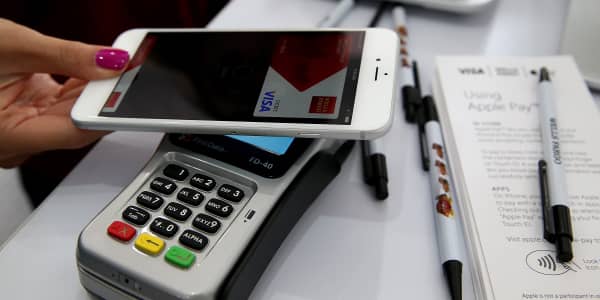Anytime you are not using cash, it reduces the pain of paying. That's not just logical conjecture, but science.
Research has found that consumers tend to spend more money with a credit card than with cash or a debit card, and the expectation is that new mobile payment tools like Apple Pay will have a similar effect.
In a study at MIT, MBA students were offered a chance to bid on tickets to a sold-out Boston Celtics game. Those who could pay with a credit card were willing to pay twice as much as those who would have had to go to the ATM and pay with cash. Another study, aptly named "Monopoly Money" and published by the American Psychological Association, also found that consumers were more conservative when they had to use cash instead of a credit card to pay for a restaurant meal.

"When you are spending cash, you see the pain of paying right there, because you see the money going out," said Joydeep Srivastava, a professor of marketing and consumer psychology at the University of Maryland's business school.
That's because using cash allows consumers to see, dollar for dollar, just how much they're spending, something they don't experience with a credit card—or a smartphone.
But why can't an app do an even better job as a budgetary hawk? It could; the app just hasn't been invented yet. But apps might ultimately do the best job of all at curbing the appetite to overspend, and researchers and financial companies are already at work on the effort.
Intervention is the key, Srivastava said, and he is planning to research and develop an app that could help consumers set budgets and stick to them. Think of the personal health-care experimentation occurring today with apps to count calories and each and every step taken throughout the day. Seeing cash come out of the wallet might give a consumer pause, but a regular wallet can't stop a determined shopper from purchasing a ridiculously expensive pair of shoes. The smartphone could be loaded with apps and other tools to help consumers manage their budget and encourage them to think twice before splurging.
One of the promised perks of Apple Pay—and rival mobile payment tools—is how easy it should be to use. Just a few taps on the smartphone to complete a transaction.
Smartphones make it easier than ever for consumers to make impulse buys and to load up on debt before realizing how much they spent—setting the state for an exponential leap from the classic credit card recklessness. Like the credit card before it, consumers merely have to whip out their mobile wallet at the cash register, and in some cases, they may not even need to take it out of their pocket at all.
But as it turns out, those little inconveniences actually have a hidden benefit: They force consumers to stop and think about how they're about to part with their money.
Giving new meaning to 'the invisible hand'
"There's a lot of discussion around payments becoming invisible. Are we going to become financially irresponsible? The reality is that technology can help," said Carey Kolaja, vice president of global product solutions at PayPal, one of many players in the mobile payments space. "We're starting to see where technology is not just making things simpler from a purchasing perspective but also giving consumers more control."
Srivastava said an app could help consumers establish a budget, monitor it in real time and even step in if necessary. For instance, if they were near their monthly allocation for entertainment or about to go over it, the app could send an alert. Better yet, it could even use the smartphone's GPS to recognize that a consumer had entered a favorite establishment and remind the consumer about how much is left in the bank.
"I'm sort of talking about it in jest, but I think in the future you'll probably see something like that," he said.
In our drive for convenience, we sometimes forget the benefits of inconvenience.Elizabeth Dunnassociate professor of psychology at the University of British Columbia
Certainly, it's something that those in the mobile payment industry are considering. Personal finance tools such as Mint help consumers see how much money they pay for food, entertainment and other expenses over a given time. Some banks and credit cards already offer personal finance and budgeting tools for their customers, though the institutions must walk a fine line between encouraging their customers to spend and helping them watch their spending. PayPal, for one, said it is developing tools to help consumers have better control of their money, such as placing thresholds and sending notifications about purchases.
Until the app version of a scissors cutting a credit card arrives, consumers can curb their mobile wallet enthusiasm and keep a tab on their spending in a more primitive technology way. Elizabeth Dunn, author of "Happy Money: The Science of Smarter Spending" and an associate professor of psychology at the University of British Columbia, uses Starbuck's mobile app to pay for coffee and only loads it with $30 in credit each week. That's her coffee budget. If that credit is gone before the end of the week, then she knows she can't—or shouldn't—order another iced latte.
"By doing it that way, I am more aware of how much I'm really spending," Dunn said.
But Dunn isn't in a hurry to throw away her wallet. It's helpful to have reminders and cues that keep spending in check, and sometimes that comes in the form of fumbling with the wallet and counting out cash. "In our drive for convenience, we sometimes forget the benefits of inconvenience," she said.


